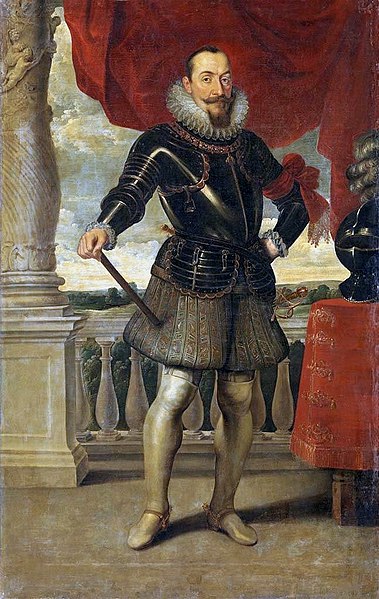The Battle of Klushino, or the Battle of Kłuszyn, was fought on 4 July 1610, between forces of the Polish–Lithuanian Commonwealth and the Tsardom of Russia during the Polish–Muscovite War, part of Russia's Time of Troubles. The battle occurred near the village of Klushino near Smolensk. In the battle the outnumbered Polish-Lithuanian force secured a decisive victory over Russia, due to the tactical competence of hetman Stanisław Żółkiewski and the military prowess of Polish hussars, the elite of the army of the Crown of the Kingdom of Poland. The battle is remembered as one of the greatest triumphs of the Polish-Lithuanian cavalry and an example of excellence and supremacy of the Polish-Lithuanian military at the time.
Polish hussar line at the Battle of Kłuszyn
Polish–Lithuanian Commonwealth
The Polish–Lithuanian Commonwealth, formally known as the Kingdom of Poland and the Grand Duchy of Lithuania, or simply Poland–Lithuania, was a bi-confederal state, sometimes called a federation, of Poland and Lithuania ruled by a common monarch in real union, who was both King of Poland and Grand Duke of Lithuania. It was one of the largest and most populous countries of 16th- to 17th-century Europe. At its largest territorial extent, in the early 17th century, the Commonwealth covered almost 1,000,000 km2 (400,000 sq mi) and as of 1618 sustained a multi-ethnic population of almost 12 million. Polish and Latin were the two co-official languages, and Roman Catholicism served as the state religion.
The Union of Lublin joined the Kingdom of Poland and the Grand Duchy of Lithuania in 1569.
Sigismund III Vasa, who reigned between 1587 and 1632, presided over an era of prosperity and territorial expansion of the Commonwealth.
Sejm (parliament) of the Polish–Lithuanian Commonwealth in the early 17th century
John III Sobieski, victor over the Ottoman Turks at the Battle of Vienna in 1683.





